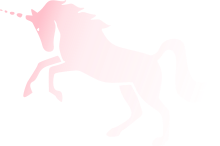Invisible Pink Unicorn
The Invisible Pink Unicorn (IPU) is the goddess of a parody religion used to satirize theistic beliefs, taking the form of a unicorn that is paradoxically both invisible and pink.[1] She is a rhetorical illustration used by atheists and other religious skeptics as a contemporary version of Russell's teapot, sometimes mentioned in conjunction with the Flying Spaghetti Monster.[2]
The IPU is used to argue that supernatural beliefs are arbitrary by, for example, replacing the word God in any theistic statement with Invisible Pink Unicorn.[3] The mutually exclusive attributes of pinkness and invisibility, coupled with the inability to disprove the IPU's existence, satirize properties that some theists attribute to a theistic deity.[4]
History

Russell's teapot is an analogy first coined by the philosopher Bertrand Russell (1872–1970) to illustrate that the philosophic burden of proof lies upon a person making scientifically unfalsifiable claims rather than shifting the burden of proof to others, specifically in the case of religion.[5] Russell wrote that, if he claims that a teapot orbits the Sun somewhere in space between the Earth and Mars, it is nonsensical for him to expect others to believe him on the ground that they cannot prove him wrong. Russell's teapot is still referred to in discussions concerning the existence of God.
The IPU seems to have become notable primarily through online culture: in addition to alt.atheism, where IPU still frequently comes up in discussions, there are now a number of web sites dedicated to Her. The earliest documented reference to the IPU was on July 7, 1990,[6] on the Usenet discussion group alt.atheism. Other sources concerning IPU state that she was "revealed to us" on alt.atheism.
The concept was further developed by a group of college students from 1994 to 1995 on the ISCA Telnet-based BBS. The students created a manifesto that detailed a nonsensical (yet internally consistent) religion based on a multitude of invisible pink unicorns.[7] It is from this document that the most famous quotation concerning IPUs originated:
Invisible Pink Unicorns are beings of great spiritual power. We know this because they are capable of being invisible and pink at the same time. Like all religions, the Faith of the Invisible Pink Unicorns is based upon both logic and faith. We have faith that they are pink; we logically know that they are invisible because we can't see them. — Serah Eley[8][9]
Concepts

It is common when discussing the Invisible Pink Unicorn to point out that because she is invisible, no one can prove that she does not exist (or indeed that she is not pink). This is a parody of similar theistic claims about God—that God, as creator of the universe, is not subject to its laws and thus not physically detecting him tells us nothing about his existence or lack thereof. The Invisible Pink Unicorn is an illustration which attempts to demonstrate the absurdity of citing attributes and a lack of evidence as proof of a deity's existence. Her two defining attributes, invisibility and color (pink), are inconsistent and contradictory; this is part of the satire. The paradox of something being invisible yet having visible characteristics (e.g., color) is reflected in some East Asian cultures, wherein an "invisible red string" is said to connect people who have a shared or linked destiny.
There are humorous mock debates amongst her "followers" concerning her other attributes, such as whether she is completely invisible, or invisible to most, but visible to those who have faith in her (bearing similarities to "The Emperor's New Clothes").[7] Some arguments are quite elaborate and tortuous, satirizing the disputatiousness and intricacy of the theological debates that occur in many religions.[7]
The Invisible Pink Unicorn is also used to de-deify religious texts. The goal is to have the reader experience the text without heavily loaded concepts that many readers will associate with omnipotence, or will read with an unquestioned faith. It is argued that when someone re-reads the same text with all direct references to God replaced with the Invisible Pink Unicorn, the reader may see the text in a new and more critical way:
In the beginning the Invisible Pink Unicorn created the heavens and the earth...and the Spirit of the Invisible Pink Unicorn was hovering over the waters. And the Invisible Pink Unicorn said, "Let there be light," and there was light. The Invisible Pink Unicorn saw that the light was good, and she separated the light from the darkness.
Similar concepts
In 1996, a unicorn that no one can see was adapted as a teaching device at Camp Quest, the first free-thought summer camp for children established in the United States, by Dr. L. Wilson. As reported years later in the July 21, 2006 Cincinnati Enquirer, "Campers must try to prove that imaginary unicorns—as a metaphor for God—don't exist."[11] Richard Dawkins alluded to unicorns in this connection in his 2006 book The God Delusion, writing that "Russell's teapot, of course, stands for an infinite number of things whose existence is conceivable and cannot be disproved. [...] A philosophical favorite is the invisible, intangible, inaudible unicorn."[12]
In the essay The Dragon in my Garage from the book The Demon-Haunted World: Science as a Candle In the Dark, Carl Sagan uses the example of an invisible dragon breathing heatless fire that someone claims lives in his garage. The supposed dragon cannot be seen, heard, or sensed in any way, nor does it leave footprints. There is no reason to believe this purported dragon exists.[13]
In the South Park episode "The Poor Kid", a strict agnostic couple tell their foster children that God might exist, but then again, it's equally possible that there might be a "giant reptilian bird in charge of everything". At the end of the episode, the bird actually does appear and eats Kenny.
Religious commentary
Abel and Schaefer have written that the concept of the Invisible Pink Unicorn only critiques religious belief, ignoring the social activities and social commitments involved in religious practice.[14][Note 1]
See also
- Conversational intolerance
- Existence of God
- Fideism
- Out Campaign
- Religious satire
- Theological noncognitivism
- Church of the SubGenius
- Discordianism
- Dudeism
- Evolution as fact and theory
- Intelligent falling
- Reductio ad absurdum
Notes
- ↑ Abel & Schaefer (2010) state (paragraph 53, page 14) "This study's findings suggest that the IPU critique of religion is mostly misdirected. The belief commitments of religious people usually have less to do with beliefs than commitments, as evidenced by the overwhelming lack of theological understanding that characterizes a typical congregation."
References
- ↑ Angeles, Peter A. (1992). Harper Collins Dictionary of Philosophy. Harper Perennial, New York. p. . ISBN 0-06-461026-8.
- ↑ Maartens, Willie (2006-06-01). Mapping Reality: A Critical Perspective on Science and Religion. iUniverse. p. 191. ISBN 0-595-40044-2.
- ↑ Narciso, Dianna (2004-03-01). Like Rolling Uphill: Realizing the Honesty of Atheism. Media Creations. p. 5. ISBN 1-932560-74-2.
- ↑ Andrew Stuart Abel; Andrew Schaefer (2010). "Seeing Through the Invisible Pink Unicorn" (PDF). Journal of Religion and Society. Rabbi Myer and Dorothy Kripke Center for the Study of Religion and Society. 12. ISSN 1522-5658.
- ↑ Fritz Allhoff, Scott C. Lowe. The Philosophical Case Against Literal Truth: Russell's Teapot // Christmas - Philosophy for Everyone: Better Than a Lump of Coal. — John Wiley and Sons, 2010. — Т. 5. — P. 65-66. — 256 p. — (Philosophy for Everyone). — ISBN 9781444330908.
- ↑ Scott Gibson (1990-07-17). "'Proof' of God's Existence". Newsgroup: alt.atheism. Usenet: [email protected]. Retrieved 2007-04-10.
how about refuting the existence of invisible pink unicorns?
- 1 2 3 Alex Tufty Ashman (2007-02-08). "The Invisible Pink Unicorn". h2g2. BBC. Retrieved 2008-05-08.
- 1 2 Judson Poling; Garry Poole; MS Debra Poling (2003). Do Science and the Bible Conflict?. Zondervan. p. 20. ISBN 978-0-310-24507-0.
- 1 2 Jack Huberman (2006). The Quotable Atheist. Nation Books. p. 103. ISBN 1-56025-969-8.
- ↑ "Kenneth" (2005-07-23). "Portrait of the Invisible Pink Unicorn". the klog.
- ↑ Clark, Michael D. (2006-07-21). "Camp: "It's Beyond Belief"". The Cincinnati Enquirer. Archived from the original on August 13, 2006. Retrieved 2006-08-16.
- ↑ Dawkins, Richard (2006). "The God hypothesis: the poverty of agnosticism". The God Delusion (Trade paperback ed.). Kent: Bantam Press. pp. 52–53. ISBN 978-0-593-05825-1. Retrieved 2007-07-20.
- ↑ Sagan, Carl (1997). "The Dragon In My Garage". The Demon-Haunted World: Science As A Candle In the Dark. Ballantine Books. pp. 171–173. ISBN 0-345-40946-9.
- ↑ Abel, Andrew Stuart; Schaefer, Andrew (2010). "Seeing Through the Invisible Pink Unicorn" (PDF). Journal of Religion & Society. 12: 14.
External links
 Media related to Invisible Pink Unicorn at Wikimedia Commons
Media related to Invisible Pink Unicorn at Wikimedia Commons
